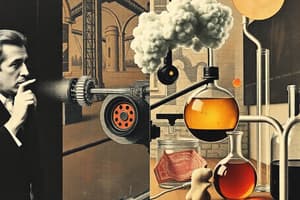Podcast
Questions and Answers
How does a well-functioning loanable funds market influence a firm's decision to borrow?
How does a well-functioning loanable funds market influence a firm's decision to borrow?
- It discourages firms from investing in resources for growth.
- It has no impact on the firm's investment decisions.
- It ensures firms have access to capital for investment in resources, supporting growth. (correct)
- It leads to decreased government spending.
What is the significance of investment in relation to GDP, according to the loanable funds market?
What is the significance of investment in relation to GDP, according to the loanable funds market?
- Investment is necessary for output (GDP), requiring borrowing, which in turn requires savings. (correct)
- Investment is independent of borrowing and savings.
- Investment leads to decreased output and GDP.
- Investment has no relation with either GDP, savings, or borrowing.
According to the perspective of suppliers in the loanable funds market, how should interest rates be viewed?
According to the perspective of suppliers in the loanable funds market, how should interest rates be viewed?
- As a fixed entity irrespective of market demands.
- As a governmental control measure.
- As an irrelevant factor in the cost of consumption.
- As the opportunity cost of consumption. (correct)
What role do households play in the loanable funds market?
What role do households play in the loanable funds market?
What entities participate in the loanable funds market?
What entities participate in the loanable funds market?
How do firms generally utilize borrowed funds in their operations?
How do firms generally utilize borrowed funds in their operations?
What is the role of commercial banks within the loanable funds market?
What is the role of commercial banks within the loanable funds market?
From a borrower's perspective, what does the interest rate primarily represent?
From a borrower's perspective, what does the interest rate primarily represent?
What is the effect of higher interest rates on the incentive to save?
What is the effect of higher interest rates on the incentive to save?
According to the loanable funds market, which is the most accurate sequence?
According to the loanable funds market, which is the most accurate sequence?
Where would you most likely find stocks and bonds?
Where would you most likely find stocks and bonds?
What does the sale of output most directly fund?
What does the sale of output most directly fund?
How is the price of Loanable Funds quoted?
How is the price of Loanable Funds quoted?
What roles do firms play in the Loanable Funds Market?
What roles do firms play in the Loanable Funds Market?
From a demander's perspective, what is the interest rate based on?
From a demander's perspective, what is the interest rate based on?
Besides commercial banks, what other financial institutions are included in the loanable funds market?
Besides commercial banks, what other financial institutions are included in the loanable funds market?
What would happen if there was no properly working loanable funds market?
What would happen if there was no properly working loanable funds market?
Which of the following is NOT a listed participant of the loanable funds market?
Which of the following is NOT a listed participant of the loanable funds market?
Which of these relies on borrowing, according to Loanable Funds Market concepts?
Which of these relies on borrowing, according to Loanable Funds Market concepts?
What happens as the interest rate increases?
What happens as the interest rate increases?
Flashcards
Loanable Funds Market
Loanable Funds Market
Market that brings together savers (supply) and borrowers (demand).
Savers
Savers
Households, Foreign Entities.
Borrowers
Borrowers
Firms, Government.
Loanable Funds Market Places
Loanable Funds Market Places
Signup and view all the flashcards
Why Firms Borrow
Why Firms Borrow
Signup and view all the flashcards
Interest Rates
Interest Rates
Signup and view all the flashcards
Borrowing leads to Production
Borrowing leads to Production
Signup and view all the flashcards
Output (GDP) Requires...
Output (GDP) Requires...
Signup and view all the flashcards
Interest Rate (Supplier POV)
Interest Rate (Supplier POV)
Signup and view all the flashcards
Interest Rate (Demander POV)
Interest Rate (Demander POV)
Signup and view all the flashcards
Study Notes
- Gases are compressible and expandable, completely fill containers, and have lower densities than liquids and solids.
Gas Pressure
- Pressure is the force per unit area exerted by gas molecules on container walls.
- $Pressure = \frac{Force}{Area}$
- Pascal (Pa): the SI unit of pressure, $1 Pa = 1 \frac{N}{m^2}$.
- Other pressure units:
- 1 atm = 760 mmHg = 760 torr = 101.325 kPa
- 1 bar = $10^5$ Pa
The Gas Laws
- These laws describe relationships between gas volume (V), pressure (P), temperature (T), and the number of moles (n).
Boyle's Law
- At constant temperature and number of moles, gas volume is inversely proportional to pressure: $V \propto \frac{1}{P}$.
- $P_1V_1 = P_2V_2$
Charles's Law
- At constant pressure and number of moles, gas volume is directly proportional to absolute temperature: $V \propto T$.
- $\frac{V_1}{T_1} = \frac{V_2}{T_2}$
- Use Kelvin for temperature: $T(K) = t(°C) + 273.15$
Avogadro's Law
- At constant pressure and temperature, gas volume is directly proportional to the number of moles: $V \propto n$.
- $\frac{V_1}{n_1} = \frac{V_2}{n_2}$
The Ideal Gas Law
Ideal Gas Law
- The ideal gas law combines Boyle's, Charles', and Avogadro's laws: $PV = nRT$.
- The ideal gas constant is $R = 0.08206 \frac{L \cdot atm}{mol \cdot K} = 8.314 \frac{J}{mol \cdot K}$.
- Standard Temperature and Pressure (STP) is $0°C$ (273.15 K) and 1 atm.
- At STP, one mole of an ideal gas occupies 22.4 L, which is the standard molar volume.
Gas Density and Molar Mass
- Density is $d = \frac{m}{V}$
- Molar mass is $M = \frac{m}{n}$
- Use the ideal gas law to find density: $d = \frac{PM}{RT}$
- Use the ideal gas law to find molar mass: $M = \frac{dRT}{P}$ or $M = \frac{mRT}{PV}$
Gas Mixtures and Partial Pressures
Dalton's Law of Partial Pressures
- The total pressure of a gas mixture equals the sum of each gas's partial pressures: $P_{total} = P_1 + P_2 + P_3 +...$
- $P_i = n_i \frac{RT}{V}$
Mole Fraction
- The mole fraction of a gas in a mixture is the ratio of its moles to the total moles: $X_i = \frac{n_i}{n_{total}}$
- A gas's partial pressure equals the total pressure times its mole fraction: $P_i = X_i \cdot P_{total}$
The Kinetic Molecular Theory of Gases
Main Assumptions
- Gas particle size is negligible compared to the space between them.
- Gas particles move randomly and continuously.
- Collisions between particles and container walls are elastic (kinetic energy is conserved).
- There are no intermolecular forces between gas particles.
- The average kinetic energy of gas particles is proportional to absolute temperature.
Kinetic Energy and Root Mean Square Speed
- Average kinetic energy is $KE_{avg} = \frac{3}{2}RT$
- Root mean square speed is $u_{rms} = \sqrt{\frac{3RT}{M}}$, where M is molar mass in kg/mol.
Graham's Law of Effusion
- The rate of effusion is inversely proportional to the square root of molar mass: $\frac{Rate_1}{Rate_2} = \sqrt{\frac{M_2}{M_1}}$
- Effusion: gas escaping through a small hole.
Real Gases: Deviations from Ideal Behavior
Real Gases
- Real gases deviate from ideal behavior at high pressure and low temperature.
- Intermolecular forces exist between gas particles.
- Gas particles have a finite volume.
van der Waals Equation
- The van der Waals equation corrects for deviations from ideal behavior: $[P + a(\frac{n}{V})^2](V - nb) = nRT$
- $a$ accounts for intermolecular forces.
- $b$ accounts for the finite volume of gas particles.
- $a$ and $b$ are van der Waals constants specific to each gas.
Studying That Suits You
Use AI to generate personalized quizzes and flashcards to suit your learning preferences.




